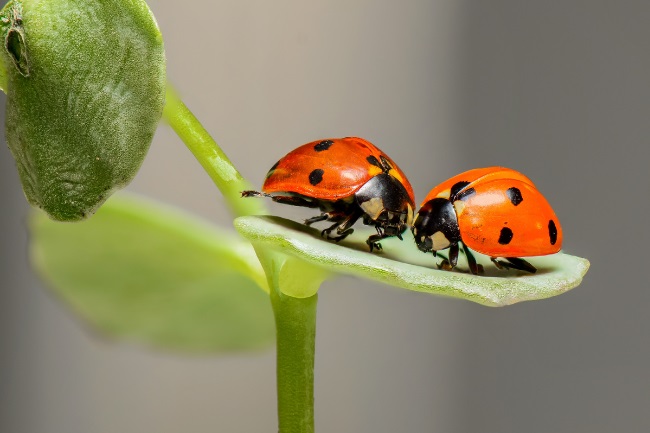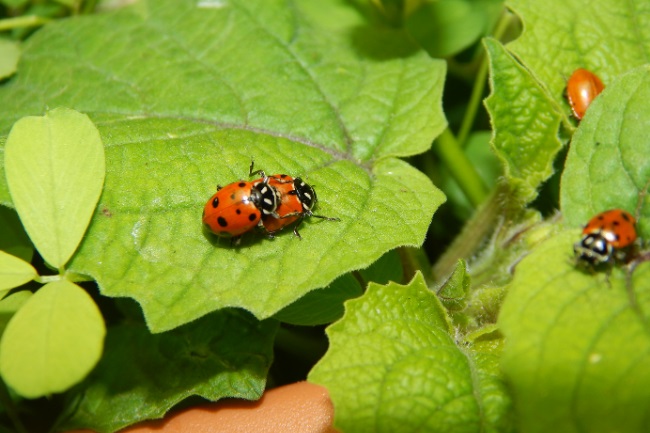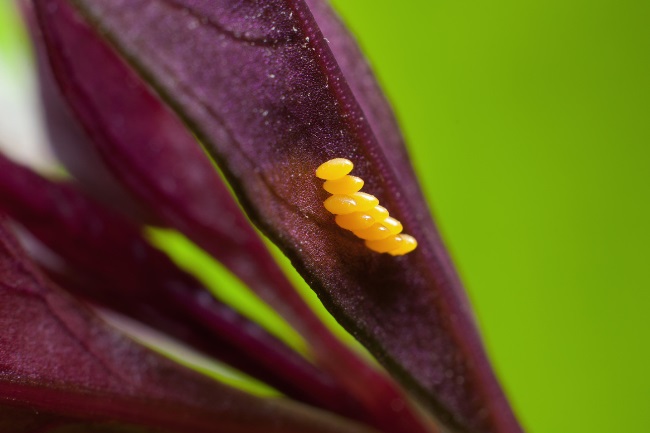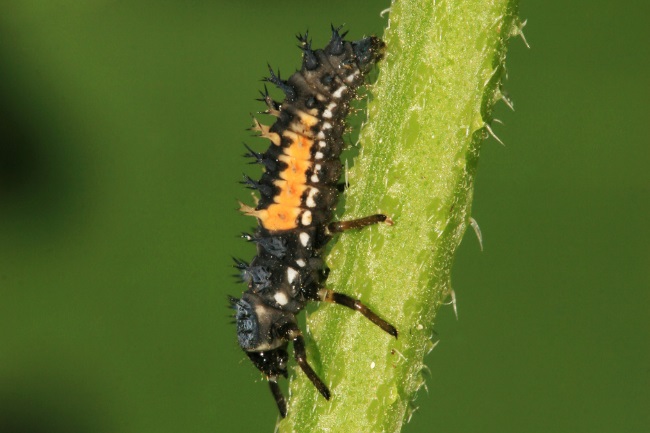Ladybugs reproduce through a male and female of the same species mating. They do not mate for life, and neither parent takes care of the young after the female has laid her eggs.
Contents
Finding a mate
A ladybug’s reproductive life begins shortly after it has emerged from its pupa into its final adult form. Within a few days, it can be ready to mate, and will then continue to do so throughout the spring and summer, before it enters its winter dormancy.
Ladybugs reproduce sexually, rather than asexually through the creation of clones, as aphids their main prey species can. This means for there to be more ladybirds in the future; you need to start with a male and a female of the same species. This might sound easy, but for many ladybugs, it’s challenging to tell the sexes apart. Even the ladybugs themselves can get confused, with males regularly mounting other males and then retreating when they realise their mistake.
| Fact | Description |
|---|---|
| Female ladybugs lay hundreds of eggs | Adult female ladybugs deposit eggs on leaves or near aphid colonies |
| Ladybug larvae consume aphids and pests | Larvae are voracious predators and feed on soft-bodied insects |
| Pupae are immobile and undergo transformation | During the pupal stage, metamorphosis occurs and adult forms develop |
| Ladybugs can reproduce multiple times | Female ladybugs can lay multiple batches of eggs during their lifespan |
There may be small differences in markings in some species, such as in the three-banded ladybug (Coccinella trifasciata), where varying amounts of white on the head can be used to separate the two sexes. However, for most species, the only reliable indication is the slightly larger size of the female and the identification of the genitals, though, without a microscope and a keen eye, this too might be tricky.
One thing that can aid the process is the release of pheromones to attract a mate. Studies have shown that females may be cued to release these attractive chemicals by the presence of a suitable amount of food. The scent signals can be critical for these tiny insects to find each other within the wild tangles of vegetation that they often live in.

Once the ladybugs have located a potential mate, the courtship itself often isn’t anything to write home about. Some reports suggest newly hatched females may make it a little more difficult for males, demanding a bit of wooing before allowing them to mount.
In contrast, experienced females simply get on with the job. As with many species the male mounts the female from behind to perform the act, which can be quite a feat given that she is generally larger, and has a shiny curved shell he needs to clamber on top of. For added support, the male will grasp the edge of the elytra to keep himself stable.
If you find two ladybugs in this romantic embrace, you’ll notice how still they seem. Whilst the males of some species may rock a little most of the mating looks pretty uninteresting to the human eye.
However, whilst the act itself may not be so exciting, what is pretty impressive is how long it lasts. Copulation takes on average two hours but can stretch across many more. This might seem like a foolish risk to take, given how many predators would be very happy to catch two ladybugs off-guard. Still, as with many species that take their time in mating, it’s believed to be the male’s way of ensuring he keeps his competitors at bay. By clinging onto his female, the male looks to give himself a genetic advantage, however, ladybugs do not mate for life, and the female will mate with many other males throughout the season.

Once he has deposited his semen, the male will head off into the sunset, searching for more females with whom he can mate. Rather unromantically he may have left behind more than his DNA. Studies have found that many ladybugs are riddled with sexually transmitted diseases, particularly mites that live beneath the elytra and feed on the ladybug’s blood.
These hitch-hiking vampires have plenty of time to migrate from one host to another during the extended copulation and therefore have found themselves relatively a profitable niche. Though these pests generally don’t kill the ladybug, the drain on the females’ resources can lead to smaller, or fewer eggs being produced.
| Life Cycle Stage | Duration |
|---|---|
| Egg | 3-7 days |
| Larva | 2-4 weeks |
| Pupa | 7-10 days |
| Adult | Several weeks to several months, depending on species |
The semen that the male has deposited within the female will not necessarily be used straight away, and she can choose to store it for several months. It can be used to fertilise several batches of eggs, meaning that she technically wouldn’t need to mate again. She keeps mating throughout the season to get the best genetic diversity within her offspring.
Unlike species that have fewer offspring and care for them for longer, who generally are more selective of who they pair with, species like the ladybug will produce as many young as possible. They will use many different combinations of genes hoping that the best of the bunch will live to reproduce themselves. This tactic works well for those lower down in the food chain or those that have a higher mortality rate. Genetic testing on clutches of eggs has found that even within groups laid simultaneously by the same female; there may be the DNA of several males present.
A safe place to hatch
Once the female has been mated, she will find a good spot to lay her eggs. From a ladybug’s perspective, a’ good spot’ is one close to a reliable food source. Although most ladybugs eat aphids and other pests around 10% of them opt for other food sources, such as plant moulds. For a herbivorous (plant-eating) or fungivorous (fungus-eating) ladybug finding a good food source is as simple as locating the right plant or plant infested with the suitable mould.
It’s a little more complicated for carnivorous ladybugs as their prey can move. For example, aphids live in boom and bust colonies, expanding rapidly and crashing quickly, with remaining individuals moving on. Therefore, the female must lay her eggs near a relatively young colony, which will continue to grow whilst her young ones develop. It’s thought she does this through visual cues and chemicals let off by the aphids themselves.
What does a ladybug egg look like?
Insect eggs can be tricky to identify, in part because they are so small, and also because many of them can look very similar. Most ladybug eggs are an elongated oval shape, orangey-yellow in colour. Most common species lay them in groups of 10 – 50, though some may only lay a handful whilst other species may lay many more. It is thought that not all of the eggs are fertile, with some unfertilised eggs laid which the hatching larvae can use as their first snack. This isn’t uncommon in the animal kingdom, with many frog species feeding their tadpoles on unfertilised eggs.

Once laid, the female won’t care for her eggs, merely abandoning them to their fate. However, due to ladybug’s cannibalistic nature, she will try to ensure that she doesn’t lay her eggs near another ladybug’s clutch. If the older eggs were to hatch out while her young were still helpless, the hungry larvae would no doubt guzzle up all of her precious eggs without a hint of remorse. Other dangers to the young come from predators such as beetles. The harlequin ladybug is particularly famous for enjoying eating other ladybugs eggs and larvae, and in Europe and the United States of America, where it has been introduced as a non-native, it is now eating other ladybug species into an early grave.
What do ladybug larvae look like?
The eggs will hatch into larvae fairly swiftly for most species, between 4 – 10 days. All ladybug larvae follow the same body shape pattern, with a head, thorax and abdomen, with three pairs of legs, but other than this they can look very different. The seven-spot ladybug larvae (Coccinella septempuctatais) probably the most recognisable to many people, with its grey and black body marked with occasional orange spots. The kidney-spot ladybug (Chilocorus renipustulatus) larvae, by comparison, looks like it means business, covered as it is with many long black spines. The mealybug ladybug’s larvae (Cryptolaemus montrouzieri) look like something out of a science-fiction film, white, flattened and fluffy.

All ladybugs larvae go through several moults, where they shrug off their exoskeleton to become larger. This process can leave them vulnerable whilst they wriggle free of their old skins; however, they will never be able to fatten up enough to transform into an adult without undoing these changes. After around three to five weeks, they should have eaten their way to their final goal and entered their final metamorphosis.
Ladybug pupa
Ladybug pupa are as varied as the larvae, although most do look like a fat, rounded insect, which has hunkered down in the vegetation to rest. The nice thing about the ladybug’s pupal stage is the insects are fixed in place, giving you plenty of time to observe and appreciate them. To many people, the most familiar of the pupa are once again those of the seven-spot, or potentially of its rival the harlequin ladybug, both being orange and black. The kidney-spot ladybug continues with its theme, with the pupa covered all over in large black spikes, like something from a gothic torture chamber. The twenty- two spot ladybug has a delicate pale yellow pupa, covered with small black spots.
The adult will emerge from the pupa around a week later, allowing its exoskeleton to harden before heading off into the world to start the cycle all over again.

